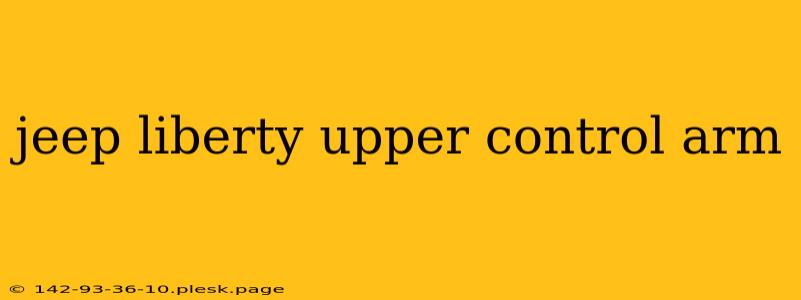The Jeep Liberty, known for its ruggedness and off-road capabilities, is not immune to wear and tear. One common issue that Liberty owners face is problems with the upper control arms. This guide will delve into the symptoms of a failing upper control arm, the process of diagnosing the problem, and the steps involved in repair or replacement.
Understanding the Jeep Liberty Upper Control Arm
The upper control arms are crucial suspension components. They connect the vehicle's frame to the steering knuckles, influencing wheel alignment and overall handling. Deterioration of the upper control arms can lead to a variety of issues, impacting both safety and performance. Factors like age, off-road driving, and general wear and tear contribute to their eventual failure. Understanding their function is the first step in addressing potential problems.
Symptoms of a Failing Upper Control Arm
Several tell-tale signs indicate that your Jeep Liberty's upper control arm might require attention:
- Uneven tire wear: This is often a primary indicator. If your tires are wearing unevenly, it could be due to misalignment caused by a faulty upper control arm.
- Wandering or pulling steering: A noticeable pull to one side while driving, or difficulty keeping the vehicle in a straight line, points towards suspension issues, including problematic control arms.
- Unusual noises: Knocking, clunking, or other unusual sounds emanating from the front suspension, particularly when going over bumps, often signify worn or damaged control arms.
- Visible damage: Inspect the control arms themselves for cracks, bends, or excessive rust. This visual inspection can quickly reveal significant damage.
- Worn ball joints: The ball joints are integral to the upper control arm; wear and tear here necessitates replacement of the entire arm.
Diagnosing the Problem
Before embarking on a repair or replacement, a proper diagnosis is crucial. This typically involves a thorough visual inspection and, in some cases, professional assistance from a mechanic.
Visual Inspection
Carefully examine the upper control arms for any signs of damage such as:
- Cracks in the metal: These are particularly dangerous and require immediate attention.
- Bent or deformed arms: Even slight bends can significantly impact vehicle handling and stability.
- Excessive rust or corrosion: Rust weakens the structural integrity of the control arm, making it prone to failure.
- Loose or damaged bushings: Worn bushings allow excessive movement within the control arm, leading to instability and poor handling.
Professional Diagnosis
If a visual inspection reveals no obvious problems but you are still experiencing symptoms, consider consulting a qualified mechanic. They can perform a more thorough inspection, including checking for play in the ball joints and assessing the overall condition of the suspension system.
Repair or Replacement: Making the Decision
In some cases, minor damage to the upper control arm may be repairable. However, if the damage is significant, replacement is almost always recommended. Replacing the entire arm ensures safety and restores optimal suspension performance. Remember, compromising on safety is not an option when it comes to your vehicle's suspension system.
Conclusion
Maintaining your Jeep Liberty's suspension system is vital for safe and reliable driving. Regularly inspecting the upper control arms for signs of wear and tear, and addressing any issues promptly, will help prevent more serious and costly problems down the line. If you're unsure about the condition of your control arms, seek professional assistance to ensure the safety and longevity of your vehicle.

